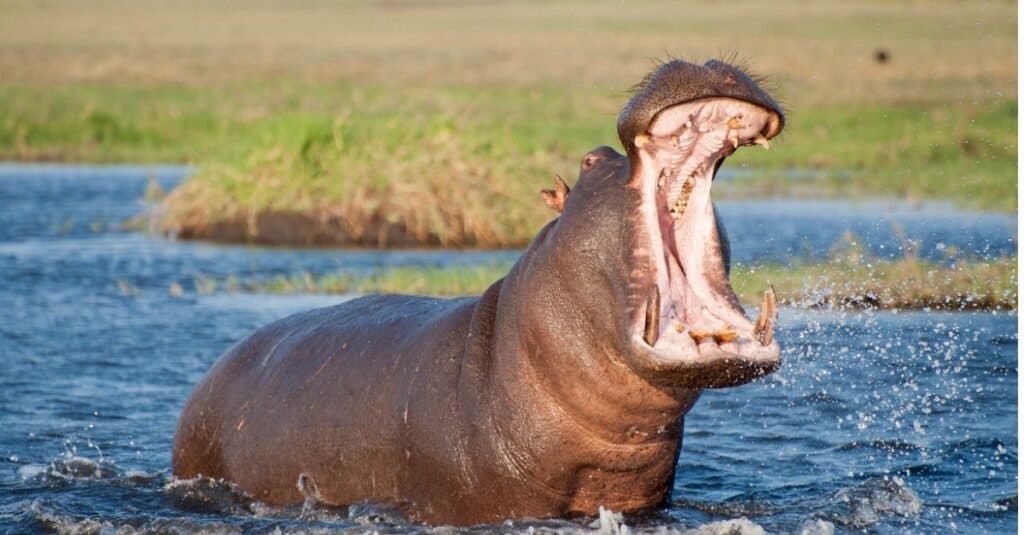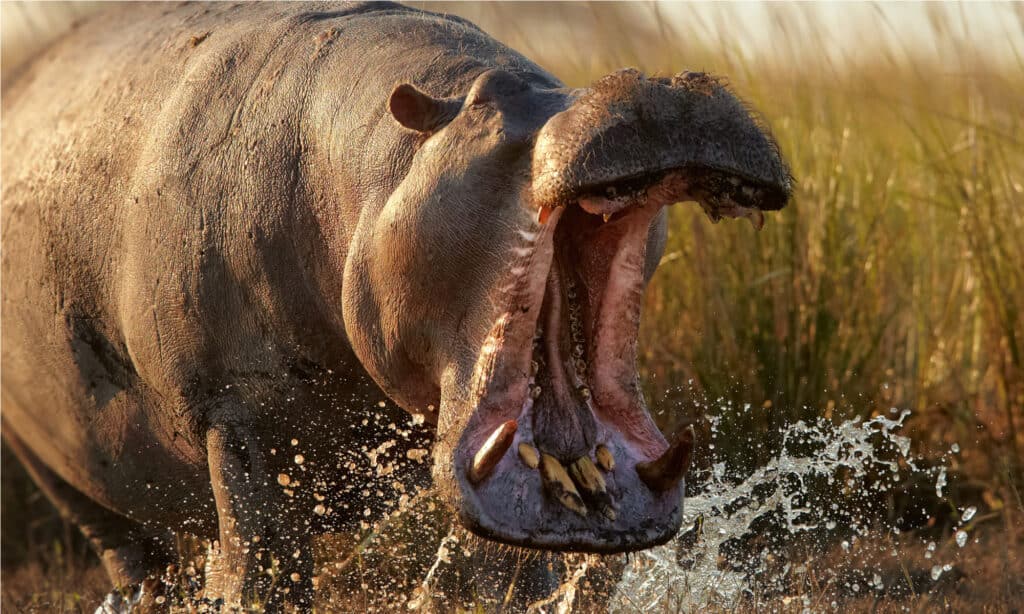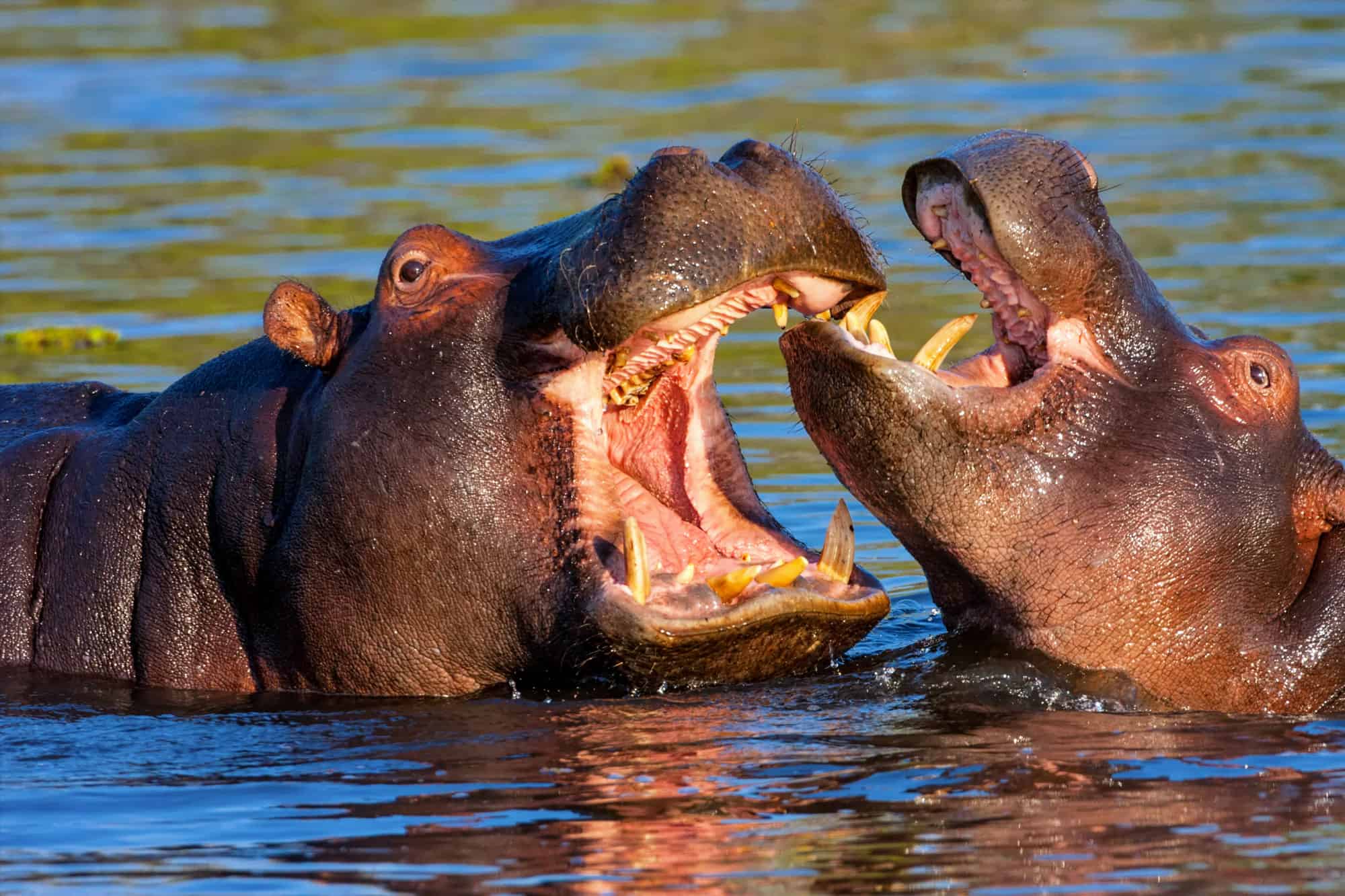The hippopotamus (Hippopotamus amphibius) normally resides in sub-Saharan Africa. However, this three-ton semiaquatic mammal has become a problem some 7,500 miles from its native range in the Antioquia province of Colombia. That’s where an estimated 130 hippos now reside in local rivers.

Hippos are now an invasive species in a highly unlikely place… South America.
©John Carnemolla/Shutterstock.com
How Did These Hippos Get There?
How did these giant African animals end up in South America? They are the descendants of four hippos illegally smuggled into the country by the Colombian drug lord and narcoterrorist Pablo Escobar.
At the height of his power, the so-called “king of cocaine” controlled 80% of the cocaine trafficked into the United States. Escobar was worth an estimated $30 billion, landing him on the list of Forbes Magazine’s ten wealthiest people in the world.
To say Escobar lived lavishly would be a gross understatement. His “Hacienda Napoles” estate covered 7.7 square miles. Among other extravagances, the complex featured a private airport and a Formula One racetrack. There was also a zoo complete with antelope, exotic birds, giraffes, zebras, elephants, ostriches, and the four hippos that are the root of the current problem in Colombia.
Escobar was shot and killed as he attempted to evade capture by police on December 2, 1993. After his death, the hippos were left on the grounds of the kingpin’s former estate. In retrospect, that was a poor decision, to say the least.

This is the entrance of Escobar’s estate, pictured more than 20 years after his death.
©Jess Kraft/Shutterstock.com
An Invasive Hippo Boom
Some locals seem to be just fine with these African giants. The so-called “cocaine hippos” have become a bit of a local tourist attraction. Many now refer to them as the “village pets.” It’s not uncommon to see one of these three-ton giants walking through the streets of river villages, stopping traffic as it passes through. In reality, these animals are anything but pets.
High Birth Rate
Hippos have no natural predators in Colombia. There is ample food and water, and the climate is perfect for them. As a result, the hippos are reproducing prolifically. The four hippos that were originally smuggled to Colombia in 1981 have now multiplied to the current estimate of 130 today. They are spread throughout a roughly 200 square mile area. Scientists warn that the number could grow to 400 hippos in the next eight years, and possibly 1,500 in 16 years. At that point, the invasive hippo population almost certainly could not be stopped.
High Level of Danger
Hippos are among the most dangerous animals in the world. They are highly territorial and can quickly become aggressive. Hippos are responsible for more deaths in Africa than any other large animal. They cause an estimated 500 human fatalities each year. There have been a few attacks on humans in Colombia, though none have resulted in fatalities yet.
In addition to the risk posed to humans, the hippos in Colombia represent a significant risk to the ecosystem in the rivers they currently inhabit. Hippo feces change the water composition and could deleteriously impact indigenous animals such as capybaras and endangered Antillean manatees. The increase of cyanobacteria from the hippos could cause toxic algal blooms. Such blooms reduce water quality and can cause mass fish deaths. That would be devastating to the river ecosystem, not to mention the economic impact on the local villages that depend on the fishery as the mainstay of their economies.
Experts caution that traffic accidents and hippo attacks are going to become more common if the hippos continue to proliferate. They also point out that illegal trafficking of baby hippos is already happening. The black market sales of these animals will only increase as the hippos multiply.

Hippos consistently rank as one of the world’s deadliest animals.
©Martin Mecnarowski/Shutterstock.com
A New Plan
Colombia’s government declared the hippos a toxic invasive species. Plans to sterilize or kill the invasive hippos were scrapped, at least partly due to public pressure, including a lawsuit in a U.S. court (the suit was largely symbolic, though, as it carried no legal consequence in Colombia).
Rather than simply eliminate the hippos, a new plan to relocate 70 of them to India and Mexico is now in place. Greens Zoological Rescue & Rehabilitation Kingdom in Gujarat, India, has agreed to take 60 of the hippos, even covering the cost of transporting the three-ton animals nearly 10,000 miles.
An additional ten hippos will be sent to zoos and wildlife sanctuaries in Mexico. Colombian officials also report interest from Ecuador, the Philippines, and Botswana in taking even more of the invasive “cocaine hippos” currently occupying Colombian rivers.

Colombian officials are finding homes for the descendants of Escobar’s illegally smuggled hippos.
©iStock.com/mesut zengin
The photo featured at the top of this post is © JMx Images/Shutterstock.com
Thank you for reading! Have some feedback for us? Contact the AZ Animals editorial team.






